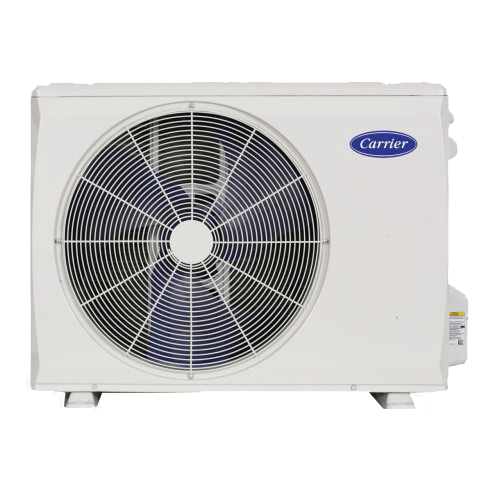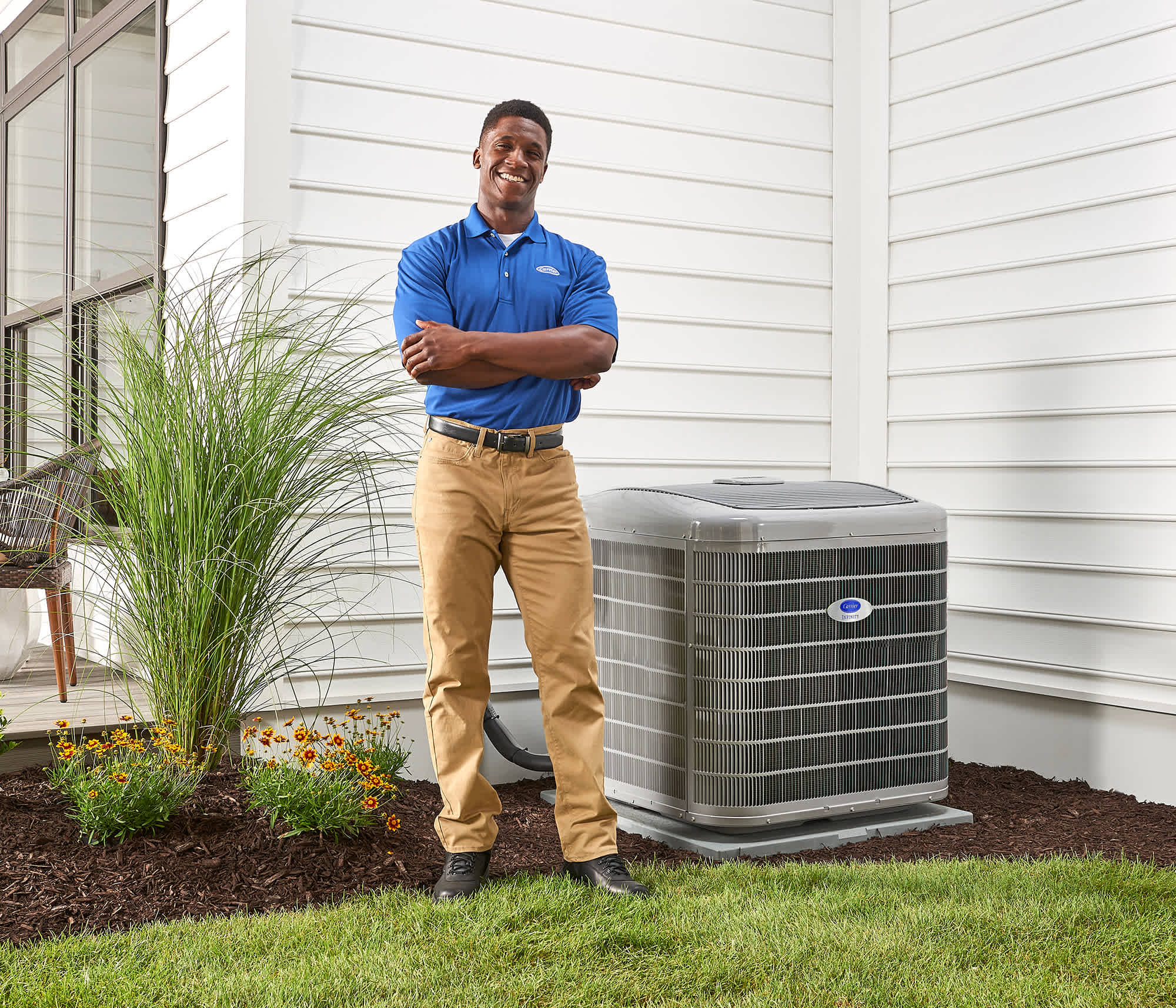How to Install a Ductless Mini Split AC
By Ryan Mayes
Installing a ductless mini split differs from installing a traditional air conditioner since ductwork isn’t needed. Of course, to the average homeowner, knowing how to install a mini split ductless system is not about the hands-on experience. It's about providing a solid understanding about where and when a ductless mini split installation makes the most sense, then letting an experienced HVAC technician do the rest.
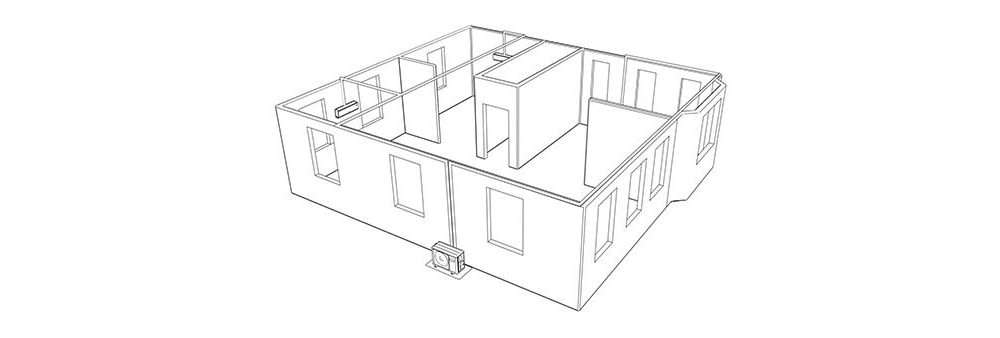
A ductless mini split heat pump or air conditioner can be a great choice for heating and cooling an older home with no existing ductwork, supplementing a ducted system in rooms that are not adequately heated or cooled, and for adding comfort to room additions or a converted space (such as air conditioning for a garage, basement, or attic). From picking the placement of indoor and outdoor units to choosing a system with great efficiency and a high SEER, mini split installation can come with many different considerations. Learn the different options for your mini split install.
How to Prepare For Your Ductless Mini Split Installation
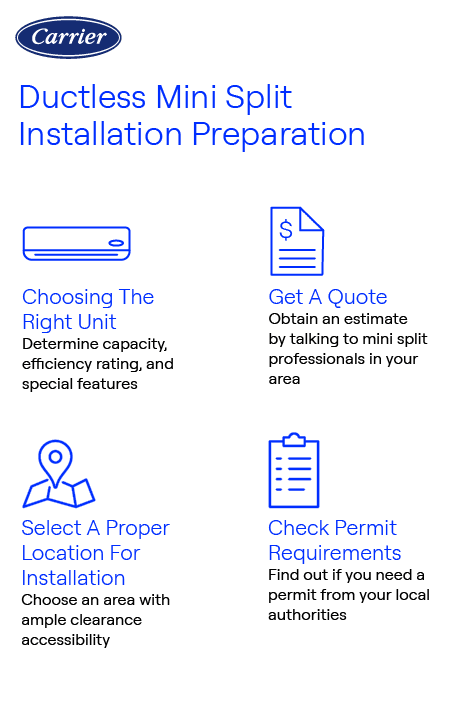
Preparing for a ductless mini split installation involves careful planning to ensure the system is properly sized, positioned, and installed according to local building codes. Proper preparation can streamline the process and help avoid unnecessary delays. Here are some key steps to take:
- Choosing the Right Unit: To choose the right unit size, consider the square footage of the space you wish to cool or heat, as well as the insulation, number of windows, and climate. An HVAC professional can help determine the ideal unit capacity for your needs. Learn more about how big of a mini split do I need?
- Select a Proper Location for Installation: Choose a location that allows for easy airflow, proper drainage, and minimal exposure to outdoor elements. The unit should be installed on an exterior wall, away from direct sunlight and obstructions.
- Check Permit Requirements: Many areas require permits for installing a mini split due to the electrical and refrigerant work involved. Check with your local building department to determine if a permit is necessary and whether you need a licensed contractor to obtain it.
- Get a Quote from a Dealer: It’s important to get a quote from a Carrier professional to ensure the correct unit size and installation location. A detailed quote will consider factors like system requirements, specific room needs, and any other relevant installation factors.
Installing an Indoor Ductless AC
Installing an indoor ductless AC unit requires careful planning and precise execution to ensure it operates effectively. By following the proper steps, including the right positioning, sizing, and electrical connections, you can enjoy the benefits of mini split efficiency. Here's a breakdown of the installation steps:
- Choose the Right Location: Ensure the location allows for proper airflow and avoids direct sunlight or obstructions
- Properly Size the Unit: The unit should be properly sized for the space to ensure efficient operation and comfort.
- Install the Mounting Bracket Securely: Attach the mounting bracket to a sturdy wall using pilot holes, ensuring the unit will be securely supported.
- Manage Refrigerant and Electrical Connections: Carefully connect the refrigerant line set and electrical connections according to manufacturer instructions and safety codes.
- Ensure Proper Drainage: Install the drainage line to avoid water buildup around the unit.
- Keep the Indoor and Outdoor Units Close: Minimize the distance between the indoor and outdoor units for efficient refrigerant flow and energy savings.
- Test Before Finalizing Installation: Once everything is connected, perform a test to ensure the unit is running properly and check for leaks or electrical issues.
Installing an Outdoor Ductless AC
The installation of an outdoor ductless AC unit requires careful planning to ensure stability, optimal airflow, and proper connections. By following the steps outlined below, you can ensure a successful installation that meets Carrier’s guidelines for long-term performance.
- Choose the Right Location: Select a location that allows for adequate airflow and is not obstructed by debris or overhanging branches. Ensure it’s away from direct exposure to the sun or rain.
- Secure the Unit Properly: The outdoor unit must be mounted on a solid, level surface, using pilot holes and appropriate mounting hardware to prevent vibrations.
- Optimize Airflow: Ensure the unit is placed in a location where airflow is not obstructed, allowing for maximum cooling and heating efficiency.
- Manage Refrigerant Line Routing: Carefully route the refrigerant line set between the indoor and outdoor units to minimize energy loss and ensure proper flow.
- Ensure Proper Drainage: Check that the outdoor unit has proper drainage to prevent water accumulation.
- Electrical and Safety Considerations: Make all necessary electrical connections in compliance with local codes, and ensure the unit is grounded correctly for safety.
- Perform a Final System Check: After installation, check all components, test the system, and ensure there are no leaks in the refrigerant lines and that everything is operating efficiently.
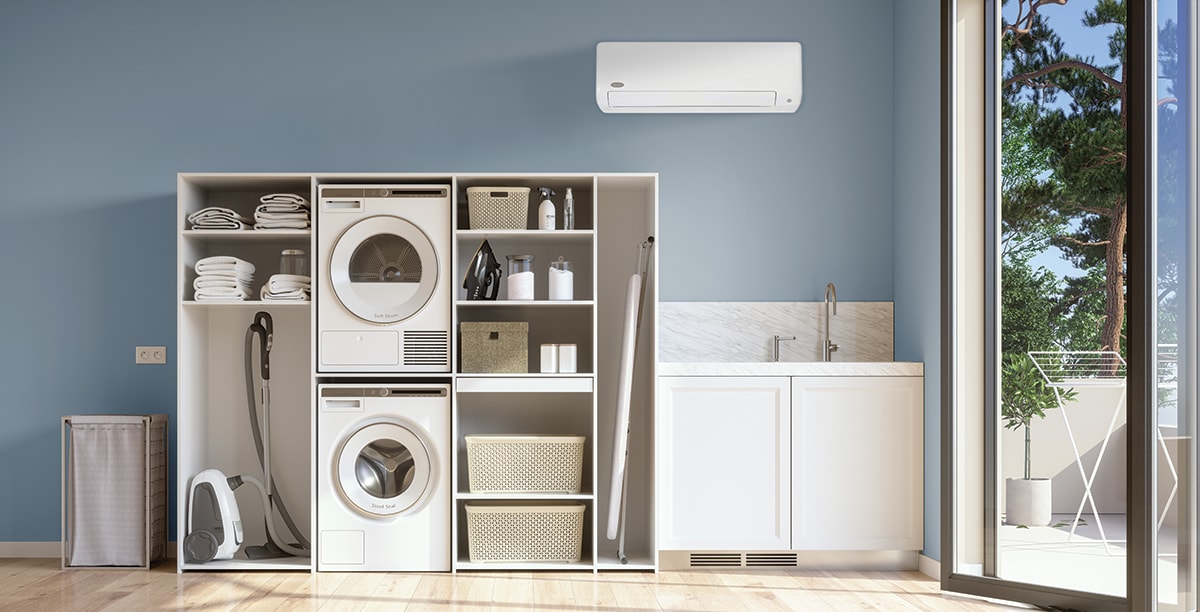
Cost of Ductless Mini Split Installation in 2025
6 Benefits of Ductless AC Installation by a Professional
While the absence of ductwork might make mini split installation seem like a great DIY project, that's far from the truth. Sure, it may be a little less complicated than installing forced air AC systems, but there are still a number of reasons why you should contact a professional to install your ductless AC or heat pump, including:
- Protect your investment: Ductless mini split air conditioners and mini split heat pumps are not cheap, and you will need additional materials such as refrigerant piping, approved wiring, refrigerant and specialized tools. You can protect your investment by also paying for professional installation.
- Easy and painless process: Most DIYers know that even the simplest projects can result in unexpected circumstances that can make the job longer, and more complicated and difficult than planned. A professional installer can often foresee issues and will likely be better equipped to handle issues that come up.
- Avoid the risk damaging your system: Amateur installers don’t have the training or experience to ensure proper installation. Common mistakes include improperly sizing the system, overcharging or undercharging the system, making the refrigerant lines too long, and not allowing enough clearance around the units.
- Risk of electric shock: Ductless installation involves running electrical wiring, including making connections with the electric service panel, installing a disconnect box and more. These tasks require great care and may cause harm to your health if not done properly.
- Energy efficiency: With their ability to only heat and cool in-use rooms and their high seasonal energy efficiency ratio 2 (SEER2), mini split ACs can be an excellent way to save on your utility bills. Professional installers can give you advice on the best locations to place indoor and outdoor units to minimize energy consumption, and can also install units correctly in order to ensure your system is running as efficiently as possible.
- Expert advice: There are many considerations when installing ductless mini split systems, including how many units you need to cover all the square footage in your home and the number of zones that will work best for your home. Ductless mini splits can be single-zone, meaning that each indoor unit has one corresponding outdoor unit, or multi-zone, meaning that multiple indoor units are connected to one outdoor unit. Measuring multiple rooms in your home and determining the correct number of units and zones on your own can be difficult without the help of a professional installer. Learn more about single zone vs multi-zone ductless systems.

Explore Carrier Ductless Air Conditioners
A Carrier ductless air conditioner offers flexible, energy-efficient cooling without the need for extensive ductwork, making it ideal for homes with limited space or existing duct systems. With precise temperature control for individual rooms or zones, it ensures personalized comfort and can lead to lower heating and cooling costs. Additionally, Carrier's ductless systems are designed for quiet operation and easy installation, providing an effective and discreet heating and cooling solution. Explore Carrier's line of ductless air conditioners today.
Single-zone system with up to 35.1 SEER2 and 30 HSPF2 for premium energy savings.
Single-zone system with up to 26 SEER2 and 13.9 HSPF2 for premium energy savings.
Ductless Mini Split Installation FAQs
Even when hiring a professional, many people have questions about ductless Mini split AC installation which may impact their decision-making when deciding whether ductless is the right answer. Here are some common questions:

The distance between the indoor unit and the outdoor compressor in a mini split air conditioner or heat pump system can vary, based upon the manufacturer’s specifications. For flexibility of placement and other reasons, some manufacturers like Carrier offer units that allow longer lineset lengths of up to 328 feet. Most average installations are likely shorter.
Many ductless mini split systems require a 14 AWG, 4 conductor stranded cable that not only delivers power to the system, but carries information between the indoor and outdoor units as well. The cable will often need to run through conduit per local code.
Smaller units may only require 110 volts, but many ductless mini split systems require 220 or higher voltage on its own breaker.
Manufacturer’s recommendations vary, but your outdoor unit will need clearance for air to flow through the unit’s condenser coil and out of the unit to allow for the heat transfer needed for the heating or cooling operation.
Check out this article and discover what is Ductless AC.
Home Advisor reports that the average cost to install a mini split is around $7,500, but the actual mini split cost can range from $1,200 to $17,000 depending on various factors.1 These factors include the size and complexity of the installation, the number of zones, and the efficiency rating of the unit. While high-efficiency models may have a higher upfront cost, they can save homeowners money in the long run due to their increased energy efficiency compared to traditional heating and cooling systems. Additionally, labor costs play a significant role in the overall cost of installation. Since each home has unique needs, it is recommended to consult with a local Carrier expert for an in-home consultation to determine the exact cost to install a mini split heat pump system.
In most cases, a small hole will need to cut in the wall to install a mini split system. This is because the indoor unit of the mini split in most cases is mounted on the wall and connected to the outdoor unit through a small conduit that runs through the hole in the wall. The size of the hole will depend on the size of the conduit, which typically ranges from 2 to 3 inches in diameter.
To determine a good SEER2 rating for your mini split heat pump, you'll need to consider your specific requirements and budget. SEER2 (Seasonal Energy Efficiency Ratio) is a measure of the cooling output of an air conditioner or heat pump over a typical cooling season, divided by the energy it consumed in watt-hours during that period. A higher SEER2 rating means a more energy-efficient unit and lower energy bills. As of January 1, 2023, the Department of Energy mandated a minimum SEER2 rating of 15. However, mini split heat pumps available today have SEER2 ratings ranging from 17 to 42. While higher SEER2 ratings are generally more energy-efficient, they can come at a higher cost. Therefore, it's crucial to find the right balance between efficiency and cost that suits your particular requirements and budget.
Find a Local Carrier Expert Near You
We always recommend getting a quote from a professional and working with a professional installer when setting up your new mini split system. To find a Carrier expert in your area, check out our dealer locator on our residential products website.
1 https://www.homeadvisor.com/cost/heating-and-cooling/ductless-heat-pump/
- Read about ductless air conditioner cost
- Learn about mini split repairs
- Read about mini split placement
- Learn about mini split maintenance
- How long do mini splits last?
- Comparing ductless mini split vs central air
